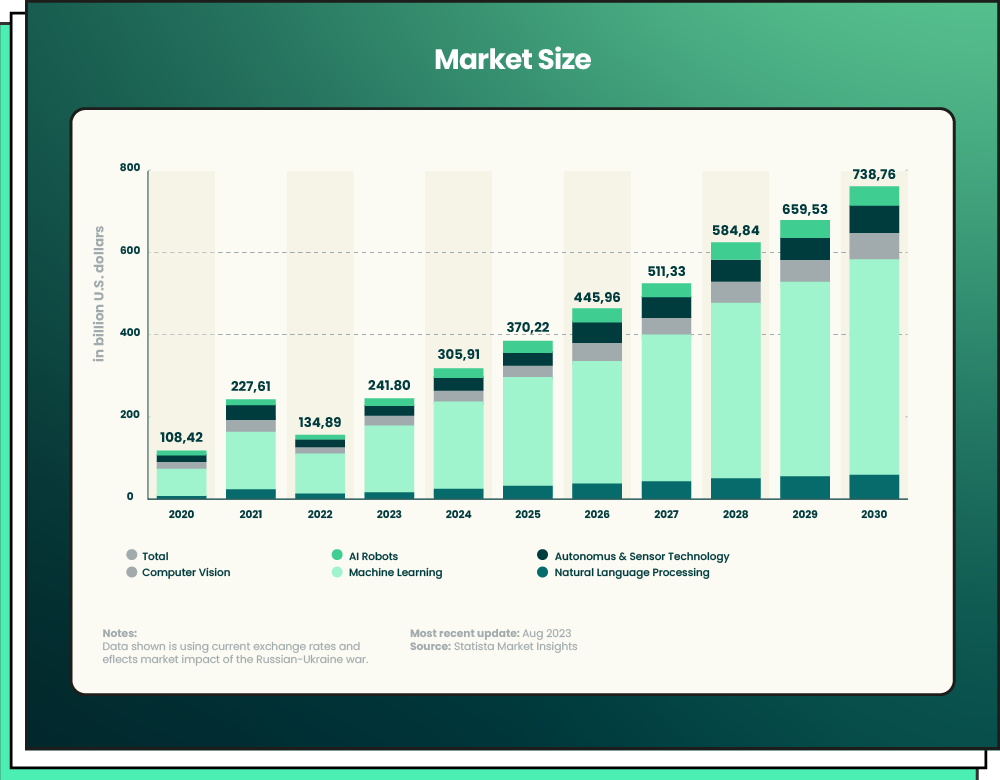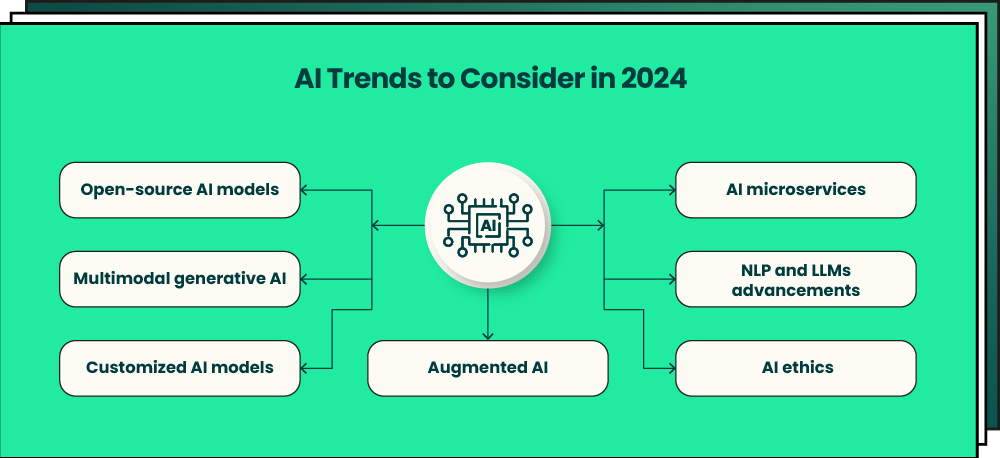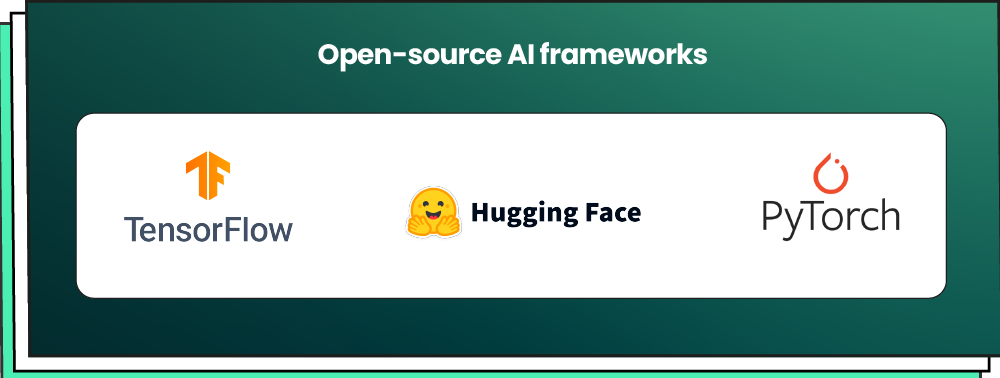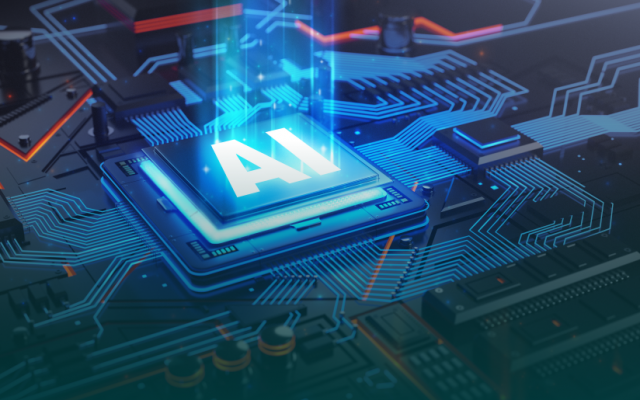2022 was a big year for AI development and expansion, laying the groundwork for significant progress in 2023. It was a time of debate about how AI could influence all spheres of human life and whether it could replace many specialists. At last, all discussions resulted in the understanding that AI is an ally, not an enemy. It reinforces human intelligence and leads to new opportunities in diverse areas.
“Artificial intelligence is not a substitute for human intelligence; it is a tool to amplify human creativity and ingenuity.” (Fei-Fei Li, Co-Director of the Stanford Institute for Human-Centered Artificial Intelligence).
2023 was the time when AI began to take root in the business world, as many industries started embracing this technology. According to Statista, in 2023, the AI market size was $241, 8 billion, expected to grow by $738, 8 billion by 2030. That year, many companies tried to integrate AI to experiment and see how it would work for their business.

2024 is a pivotal year for the future of AI and business – new AI technology, AI tools, more advanced applications, and a wide scope of opportunities for companies. These trends in artificial intelligence, ranging from open-source AI models and multimodal generative AI, will not transform the tech landscape but redefine the reasons for AI adoption.
As 2024 has already started, Forbytes has insights on top cutting-edge AI trends to consider for your business. In this article, we’ll present trends in artificial intelligence and explain how they may impact your business. Let’s get started!
AI Trends to Consider in 2024
Using insights from our collaborations with partners and customers in Europe and North America and analyzing the situation in the market, we’re thrilled to share our top AI trends and predictions for 2024. We also explored what business returns these emerging tendencies can bring to the table.

Open-source AI models for project elevation
One of the major AI trends is the emergence of open-source pre-trained models. According to the research conducted by Emerj, the open-source AI market is expected to reach $17,2 billion by 2025, with applications in such verticals as finance, education, and healthcare.
Open-source models can be combined with real-time or private data, enhancing productivity and cost efficiency. Open-source AI models are freely available for modification by anyone. As a result, this contributes to fostering a collaborative environment driving innovation and tech advances. Let’s see how open-source AI models can contribute to faster development of intelligent systems.
First, they provide available frameworks and tools, eliminating the need to build software from scratch. As a result, these models save developers time and effort, speeding up the development process.
Second, open-source AI models promote a collaborative environment, enabling engineers to contribute to the code and suggest improvements. As a result, this AI trend fosters the creation of a global brainstorming community where the best developers can work together and share unique solutions.
Finally, open-source AI models drive continuous learning, allowing developers from diverse backgrounds to share their knowledge and skills. As a result, this contributes to faster growth of AI technologies.
Here is the list of open-source AI frameworks that are more than tools, allowing for harnessing the vast potential of artificial intelligence:

TensorFlow: This model is flexible and extensible and supports Python and Javascript. It contributes to the construction and deployment of machine-learning models, providing a library of tools and robust community support. TensorFlow assists beginners in experimenting with AI.
PyTorch: This framework offers an intuitive interface, facilitating debugging and building deep learning models. Its integration with Python libraries enables efficient model training and rapid software development prototyping.
Hugging Face: This platform hosts over 250,000 models, 40,000 datasets, and 50,000 demo apps, all of which are open-source. Plus, models such as T5, RoBERTa, and BERT from Hugging Face are available in PyTorch and TensorFlow making them easily integrated into existing projects.
The popularity of open-source AI tools and community platforms proves the growing recognition of AI frameworks and the development of artificial intelligence.
Multimodal generative AI for intelligent information processing
One of the AI trends for embracing is multimodal generative AI designed to perform a few tasks like image processing and speech recognition simultaneously. According to KBV Research, the global multimodal AI market size is projected to reach $8,4 billion by 2030, showing a market growth of 32,3%.
One of the driving forces of this growth is that multimodal tools can support and perform a broader range of tasks compared to language-centric models. They can interact with audio, text, and images at the same time.
We suggest some top multimodal AI tools that can expand your scope of AI applications.

GPT-4V: This is a multimodal version of GPT-4, enabling the processing of text, audio, and images. At the same time, ChatGPT can respond to users in five different AI-generated voices, allowing them to engage with the chatbot via voice.
Google Gemini: This multimodal large language model can identify and generate diverse types of information from text, images, and video to code and audio. The value of Gemini lies in its promising performance and capacity to outperform GPT-4.
Meta ImageBind: This is an open-source multimodal AI model that can process not only text, visuals, and audio but also movement, thermal, and depth data. Meta ImageBind can combine information across six different modalities.
Customization of enterprise AI for a tailored experience
Another new AI trend that steals the show is custom artificial intelligence, knowing your business inside and delivering personalized insights. What’s the secret of custom AI models? Firstly, custom AI is about becoming smarter within the scope of a particular industry. Secondly, they’re also easier to integrate and manage.
Companies are adopting customized enterprise AI for enhanced security and better performance. With custom AI, companies can safeguard their data and achieve superior outcomes with fewer errors. Additionally, with this tailored solution, they can make more accurate predictions and data-based decisions.
This AI trend is propelled by the following factors. Firstly, businesses are used to artificial intelligence and understand its potential. That’s why they recognize the need for a tailored experience. Secondly, large volumes of enterprise data require customized AI models to unlock the full potential of information. Finally, customization empowers businesses to build AI solutions to address their unique requirements and issues.
The benefits of customized enterprise AI are multifaceted. From enhanced accuracy to streamlined efficiency, tailored AI solutions can provide more precise predictions and insights while freeing up valuable resources. Finally, with custom AI, companies can reduce implementation and maintenance costs, delivering a higher return on investment.
Augmented AI for more informed decisions
Augmented AI or Intelligence Augmentation is one of the AI trends aimed at enhancing human intelligence and decision-making. The key idea behind this new AI technology is to integrate AI with human expertise. For instance, this might involve combining data analysis with human judgment to improve outcomes across various verticals.
The value of augmented AI lies in its collaborative approach, as it is designed not to replace humans but to team up with them, providing tools and insights to make more informed decisions. Another strength of this AI technology is that it can analyze large volumes of data and present information. As a result, this saves the time and effort spent on manual data processing.
For example, Amazon Augmented AI enables the integration of machine learning in workflows, allowing humans to control the outcomes while ensuring precision and accuracy. As a result, this is a great way to enhance human capabilities and tools.
Despite the growth of augmented AI, its use cases are already evident with applications in software development. So, here are some examples of where this AI trend will be relevant:
- E-commerce platforms can use augmented AI to predict customer preferences.
- Mobile video games can employ augmented AI to create augmented-reality events and interactive gaming environments.
- Customer support services can use augmented AI to provide virtual assistance based on language processing.
- Fintech companies can apply it for monitoring and identifying stock market patterns.
AI microservices for better scalability
Integrating AI into microservices is another new AI trend embraced by companies today. More and more companies are using AI microservices to build and maintain large apps more efficiently. The benefits of this AI trend are the following:
Firstly, businesses opt for integrating AI into microservices because this is an optimal way to improve scalability, making the system easier to handle traffic and large volumes of data.
Secondly, performance is another benefit of AI microservices. AI algorithms optimize a system, enabling it to process data faster and more efficiently.
Thirdly, AI contributes to the customization of microservices, tailoring them to users’ behavior patterns and preferences.
Finally, AI algorithms enable businesses to make faster and data-driven decisions, providing real-time insights.
AI can be integrated into microservices in the following ways:
Predictive analytics. Microservices using predictive analytics, based on machine learning algorithms, provide businesses with data-driven insights, facilitating more informed decisions.
Image and video processing. AI algorithms enable microservices to recognize visual elements, making them suitable for security apps and other software, requiring visual analysis.
Natural language processing (NLP). Microservices based on NLP can be good at understanding human language, making them ideal for sentiment analysis and chatbots.
NLP and LLMs advancements for better understanding of clients’ needs
In 2024, ChatGPT is becoming less relevant, while LLMs and NLP are the prevailing AI trends for enterprises. This shift is dictated by the augmentation of local LLMs with industry-specific content for better results and enhanced data security.
As businesses face increasingly complex challenges, LLM integration is one of the AI solutions to address them. For example, companies can use an LLM to measure the degree of angriness of their clients. So, it’s possible to predict whether they can continue cooperation with this client or they will cancel their service and tend to go to competitors. LLMs will transform customer support and significantly influence buyers’ purchasing decisions.
The advancements in NLP fuel the development of more intelligent virtual assistants and chatbots, enhancing communication between people and machines. Plus, this is a good option for adapting products and services according to customer feedback.
So, both NLP and LLMs represent significant progress in sentiment analysis, enabling the differentiation between positive, negative, and neutral emotions. As a result, this is a good instrument for responding to clients’ needs and preferences.
AI safety and ethics for reliability and transparency
Today, AI is crucial in enhancing safe and ethical business practices. This AI trend stems from the potential dangers and threats associated with its use. Using advanced algorithms and machine learning, AI-based systems can identify suspicious activities related to fraud and money laundering risks. As a result, they can minimize unfair consequences.
Ethical AI solutions are built on the principles of accountability and responsibility, incorporating mechanisms for continuous monitoring and auditing. This approach ensures accuracy and transparency while guarding against biases.
Looking to Integrate AI? Trust this Matter to the Forbytes Team!
All in all, these AI trends aren’t just futuristic tech perspectives. Businesses are embracing them for innovative and advanced solutions. AI capabilities reshape industries, empower businesses, and transform workflows. In 2024, AI will revolutionize how companies apply artificial intelligence, offering more tools for better performance, enhanced customer experience, and smarter decision-making.
At Forbytes, we offer AI integration & consulting services to empower your business with AI-based solutions and unlock new opportunities. From business management and data analytics to content generation and customer service, we can integrate AI into your system to enhance its performance, optimize costs, and streamline business processes.
Our priority is to fine-tune your solution with AI to make it more intelligent and advanced. This approach helps our clients drive competitiveness, reach more clients, and achieve expected returns.
If you’re seeking a reliable AI development company, our expert team will gladly help to build AI-powered software for you. Feel free to contact us to discuss how AI can elevate your business!









